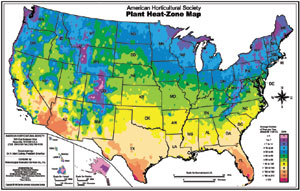





As a founding employee of Gardener's Supply, I wore many different hats over the years. Currently, I have my own company called Johnnie Brook Creative. The gardens around my home in Richmond, VT, include a large vegetable garden, seasonal greenhouse, cutting garden, perennial gardens, rock garden, shade garden, berry plantings, lots of container plants and a meadow garden. There's no place I'd rather be than in the garden.

The American Horticultural Society's Heat Zone Map is similar to the USDA's map for plant hardiness. Instead of being based on cold extremes, the Heat Zone Map is based on the number of "heat days" in a given area. For more detail, download the AHS Heat Zone Map in PDF.
If you want to grow a successful garden, you need to know the growing conditions of your site—especially, how cold it gets in the winter months. Many plants are adapted to warmer climates and will die if exposed to extreme cold.
These days, most cold-climate gardeners are very familiar with the U.S. Department of Agriculture's Plant Hardiness Zones. These 11 zones indicate the average minimum winter temperatures for a given area. Gardeners in Zone 1 can expect to see temperatures down to -50 degrees F, whereas those in Zone 11 will rarely see anything colder than 40 degrees F.
Most catalogs, web sites and garden centers now provide a Hardiness Zone rating for almost every plant they sell. If you know that you garden in Zone 5, you can be fairly confident that plants rated for Zones 1 to 5 will survive the winter in your yard.
If you're not familiar with the USDA Hardiness Zone Map, and/or don't know what zone you garden in, take a look at our Zone Finder.
But cold hardiness is not the only factor that determines whether a plant will survive in your garden or not. Too much heat can be just as damaging to a plant as too much cold.
When a plant is not cold hardy, it will simply die, but the signs of heat stress are usually more subtle. Plants that can’t tolerate high heat may stop blooming, the leaves may turn pale, and the plants may become more susceptible to pests.
In the late 1990s, The American Horticultural Society (AHS) developed the Heat Zone Map, which parallels the USDA Hardiness Zone Map. This map is based on the number of "heat days" experienced in a given area. A heat day is defined as a day in which the temperature climbs to over 86 degrees F. At this temperature, many plants begin to experience physiological damage and start to shut down their functioning. Heat Zones range from 1 (no heat days) to 12 (210 or more heat days).
Because Heat Zone ratings are relatively new, not all catalogs, web sites and garden centers currently indicate a plant’s Heat Zone. But more and more, you will begin to see two ratings for a given plant, such as 5-10, 11-1. The first pair of numbers is the cold Hardiness Zone. This plant will survive winter temperatures in zones 5 to 10. The second pair of numbers is the Heat Zone. 11-1 indicates that the plant is heat tolerant in zones 11 through 1.
When it comes to planting a garden or landscape, Heat Zones and Hardiness Zones are very important guidelines. But for best success, be sure to also consider things like rainfall, humidity, sunlight and soil pH. For more information on heat zones, read the article by H. Marc Cathey, in which he also explains some of the other environmental factors that affect plant health.
Copyright © www.100flowers.win Botanic Garden All Rights Reserved